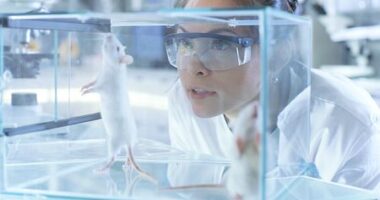Whole-exome Sequencing Discovers New Mutations in Alström Syndrome Patient

Studying mutations in the protein-coding parts of the DNA through whole-exome sequencing helps improve the clinical understanding of rare diseases such as Alström syndrome (AS), according to a case study.
The study, “Rare Compound Heterozygous Frameshift Mutations in ALMS1 Gene Identified Through Exome Sequencing in a Taiwanese Patient With Alström Syndrome” was published in the journal Frontiers in Genetics.
AS is a genetic disorder caused by mutations in the ALMS1 gene, which is involved in the function and maintenance of cellular cilia — tiny finger-like structures that help move liquid past the surface of the cell, or help the cells move. Mutations in the ALMS1 gene disrupt signals in the melanocortin-4 receptor (MC4R) pathway, which signals to the body feelings of hunger and satiety.
Diagnosis of AS often relies on primary symptoms associated with the disease, and a genetic analysis.
Researchers use DNA sequencing to compare and find genetic variations (mutations) explaining genetic disorders. A commonly used tool is called whole-exome sequencing approach, which in contrast to whole-genome sequencing approaches, limits the sequencing to exons — the protein-coding part of DNA.
In the study, researchers used whole-exome sequencing to analyze protein-coding genes of a 16-year-old Taiwanese boy with clinical features associated with AS, including early-onset blindness, juvenile obesity, and insulin resistance. Apart from these symptoms, the patient did not experience loss of hearing, an otherwise common trait in AS patients.
The patient’s DNA was isolated from blood, and the protein-coding gene regions were sequenced by the whole-exome technique. The resulting DNA sequences were then compared to a human genome reference — a collection of publicly available sequences gathered from several donors.
Researchers found 28,967 new genetic variants (genes deviating from the reference population) in the exome of the AS patient.
Among these gene variations, they identified two disease-causing mutations in the patient’s ALMS1 gene — one inherited from the mother (in exon 15) and the other inherited from the father (in exon 16). Both mutations were caused by nucleotide deletions, which were further predicted to cause a premature stop (truncation) of the ALMS1 protein.
Such truncation could result in the absence of the protein’s ALMS motif, which is essential for the formation, function, and maintenance of cellular cilia.
Overall, the whole-exome sequencing strategy allowed researchers to find a new type of mutation in an AS patient lacking some of the disease-related features, namely hearing loss. The team argued that further similar mutation screenings in the ALMS1 gene may help characterize clinical differences in AS patients based on their genetic profile.
The team believes that whole-exome sequencing is a valuable diagnostic tool for rare diseases, and highlighted its diagnostic potential and application to understand further the outcomes linked to specific ALMS1 variations. They argued that whole-exome sequencing is especially valuable because it costs less than other conventional sequencing methods.
“As compared to conventional Sanger sequencing, [whole-exome sequencing] provides an effective and efficient alternative method that aids genetic diagnosis, especially in cases with overlapping features among a certain number of differential diagnoses enlisted within the spectrum of ciliopathy,” the researchers said.




